A popular graphical technique divides the plotting area of a chart into four quadrants, to facilitate such analyses as risk-reward. For example, one axis shows risk, and the other shows reward; the quadrants divide risk and reward into low and high regions, and the quadrants show the combinations (low risk-high reward, low risk-low reward, etc.).
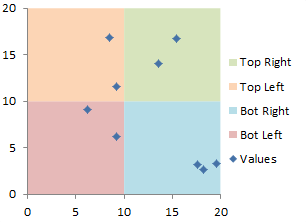
This technique is not difficult to follow in Excel. The plotted points are in an XY series, while the colored quadrants are formed by stacked area chart series.
First, The Data
All of the data needed to build a chart with colored quadrants is shown in the screenshot below. The individual values to be plotted are in the blue shaded range, B2:C11. The axis scales I want to use are in the green-tinted range, B13:D15. The data needed for the area chart series is in the light orange range, B18:G25.
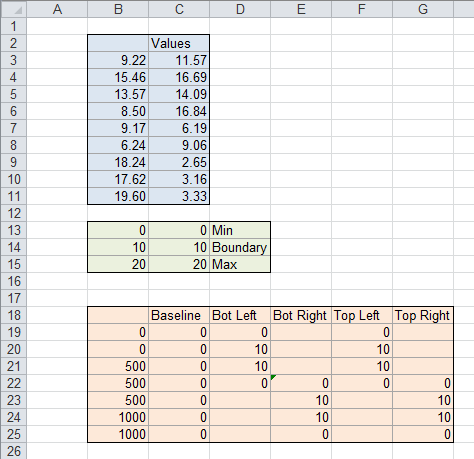
The orange (area chart) data range contains some formulas. The Baseline column is needed to ensure the same behavior in all versions of Excel (2000 through 2010). I want to scale the area chart horizontal scale from 0 to 1000 to provide enough resolution in the chart. Cells B19:B20 contain the value 0, and cells B24:B25 contain the value 1000. Cell B21 contains the formula
=(B14-B13)/(B15-B13)*1000to scale the vertical boundary to the desired point along the horizontal scale, and cells B22 and B23 link back to B21.
Cells C19:C25 link to cell C13.
Cells D19, D22, E22, E25, F19, F22, G22, and G25 also link to cell C13. Cell D20 contains the formula
=C14-C13and cells D21, E23, and E24 link to cell D20. Cell F20 contains the formula
=C15-C14and cells F21, G23, and G24 link to cell F20.
Here is a view of the formulas in the quadrant data range.

Next, the Chart
Select the blue range and insert an XY (Scatter) chart, markers only, to start the charting process (below left). Copy the orange range, select the chart, and use Paste Special to add the data to the chart as new series, with data in columns, and check the first column and first row boxes (below right). This may push all of the plotted values to the left of the chart, but I had set fixed maximum and minimum axis parameters.
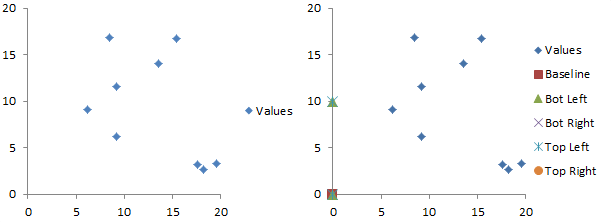
Change the Baseline series chart type to stacked area. This messes up the axes and scrunches the plotted values to the left of the chart (below left). Repeat for the Bottom Left, Bottom Right, Top Left, and Top Right series (below right). You may format the area series whenever you want. Keep in mind that Excel wants to use richly saturated colors, which will overwhelm the plotted points. I’ve used shades that are a couple of steps lighter than the default fill colors. Also keep in mind that the Baseline series should be made transparent (no fill).
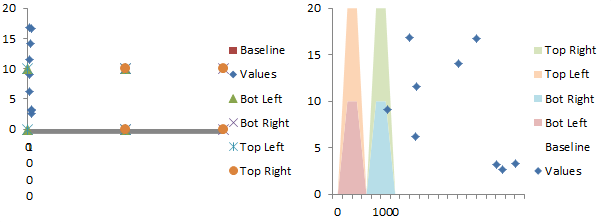
Format the Values series, and move it to the Secondary axis. This provides a secondary vertical axis (below left). On the Chart Tools > Layout tab, click on Axes and select the default Secondary Horizontal Axis option, which gives us the top of the plotting rectangle (below right).
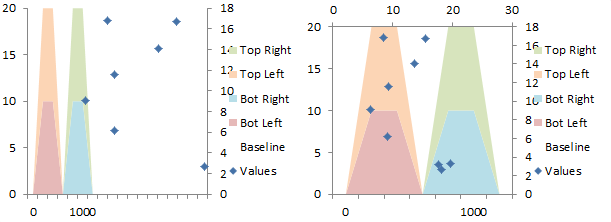
Format the left vertical axis, and under Horizontal Axis Crosses, select Maximum Axis Value (below left). Then format the right vertical axis, and under Horizontal Axis Crosses, select Automatic (below right).

Select the right vertical axis, and press Delete (below left). Format the top horizontal axis: right-click on the axis and choose Format Axis. On the Axis Options tab, under Axis Type, select Date Axis; for Axis Labels, select None; for Line Color, select No Line (below right); and under Position Axis, choose On Tick Marks. Note: Date Axis is a setting on the Axis Options tab; do not switch to the Number tab and choose a Date number format.
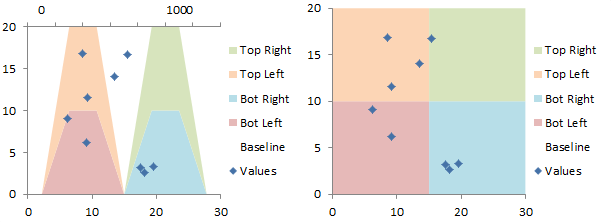
Resize the plot area if necessary (you’ll have to select Plot Area from the selection dropdown at the top left of the Chart Tools > Layout or Format tabs) and adjust any other formatting. Remove the unneeded Baseline legend entry by clicking once to select the legend and again on the “Baseline” label to select the legend entry, then press Delete. Don’t forget that Excel wants to use richly saturated colors for the area fills, which will overwhelm your value markers. Used colors that are a couple of shades lighter than the defaults. Your chart is finished.

You can change where the quadrant borders appear by changing the values in cells B14 and C14.
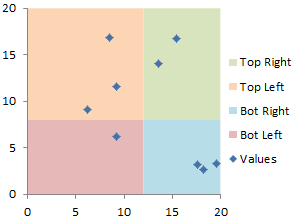
The chart adjusts as soon as you change these values.

More Combination Chart Articles on the Peltier Tech Blog
- Pareto Charts in Excel
- Clustered Column and Line Combination Chart
- Precision Positioning of XY Data Points
- Add a Horizontal Line to an Excel Chart
- Horizontal Line Behind Columns in an Excel Chart
- Bar-Line (XY) Combination Chart in Excel
- Salary Chart: Plot Markers on Floating Bars
- Shaded Quadrant Background for Excel XY Scatter Chart
- Fill Under or Between Series in an Excel XY Chart
- Fill Under a Plotted Line: The Standard Normal Curve



Joe Mako says
Thanks for putting this together Jon,
I recreated this kind of view in Tableau, but instead of a static mid point, I have it based on the median value, along with a select-able legend for filtering the view:
http://public.tableausoftware.com/views/ColoredQuadrant/ColoredQuadrant
Jon Peltier says
Joe –
Good stuff. I’m jealous of the easy filtering. I could do it with checkboxes etc, but it always takes a couple minutes.
The cells that contain the border values could always contain a formula, so the borders could indicate median or any other calculated value. That’s easy in Excel, so I’m not jealous of that.
Leonid says
When dynamic nature of a colored background is not required the quick and simple way to achive this is to color in a desired way a contiguous range of cells with proportional rows and colomns count, copying them on a clipboard and formatting Plot Area as Fill->Picture or texture fill->Clipboard.
laguerriere says
Hello Jon
thank you again for a cool tutorial. I already know that I could use it for the pain-gain matrix for our consulting presentations. Need to figure out how to add 6 quandrants though and combine it with bubble charts.
I have only one problem: I did everything like you described but the Bot Left is not coloured… It’s white on the chart and pink on the legend. Very weird.
Maybe you could help to find out why? Here is the workbook
http://www.4shared.com/file/u9UYM3pU/PTS-chart-with-colored-quadran.html
Thank you in advance!
Eric says
Jon,
I’ve been trying to automate this process (so that the user can provide data and Min/Boundary/Max values). I’ve got it so that everything works through the penultimate step (where you select Date Axis etc and the chart magically goes from being funky pyramids to the quadrants when you do this manually). I’ve checked the settings after I use VBA to set the Date Axis, Axis Labels to None, and Line Color to none and it seems to be the same as when I do the whole process manually and the chart changes to quadrants. Any idea why VBA doesn’t make the magic change from pyramids to quadrants?
I am working on an isolated LAN (w/Excel 2007) so I can’t give you the code, but I tried it at home with Excel 2010 last night and got the same incomplete results. Again, everything looks like the blog post through the very last step.
Any ideas?
Eric
Eric says
Jon,
I think that the problem may be associated with the change to Date Axis for axis type. I did this by:
ActiveChart.Axes(xlCategory).CategoryType = xlTimeScale
When this is done, the option button goes to the Date Axis option, but the change in the Format Axis box doesn’t show the Axis Options that you get when you do the change manually (i.e., Min, Max, Major/Minor units, Base unit, etc).
When I recorded the macro for this step, the only thing that was recorded was the above VB step. Did I miss something?
Thanks,
Eric
Eric says
@laguerriere
I am having the same problem with Bottom Left in my macro version of this blog entry. Let me know if you figure it out.
Thanks,
Eric
DaleW says
Jon,
Using Excel 2003, I got the same result as laguerriere and Eric: the Bot Left quadrant was the background color of the plot area (white by default).
Obviously, this was where I changed the plot area color and declared success. You might have a more elegant solution.
Thank you for this latest combo chart tutorial. (I can understand why Numbers on the iPad doesn’t even try to support combo charts imported from Excel.)
Jon Peltier says
Okay, to all of you who had a blank bottom left quadrant, I apologize. I did this tutorial with that bastard child of Microsoft, Excel 2007.
In Excel 2003 and 2010, an area chart series fills between the category axis and the data. If the category axis is at the bottom, it fills below the data. If the axis is at the top, it fills above the data. So if you’re paying attention, the area under the bottom left series is blank in the last three charts with trapezoids, and the area above the upper trapezoids is no longer blank, but has the fill color of the bottom left series.
Excel 2003: Area chart fills between axis and data.
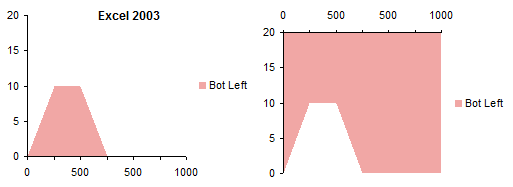
Excel 2010: Area chart fills between axis and data.
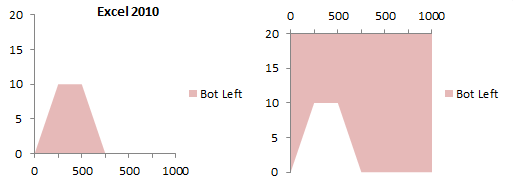
Excel 2007: Area chart fills below data.
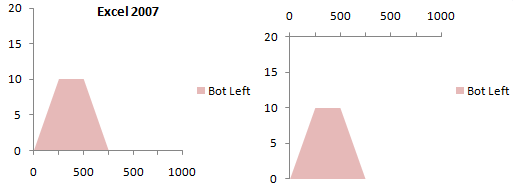
The other area series look the same in all versions, because these stack on top of the first series, that is, on top of the data of the first series.
I’ve corrected this protocol by inserting a dummy transparent series with values equal to the minimum of the vertical axis. This series will always reach to the bottom of the chart, as in the >500 half of the charts shown in this comment.
laguerriere says
Thank you Jon, it works now!
James says
Hi Jon,
Thanks for your renewed colored quadrant method.
Building on it, I am trying to replace markers with oval shapes to simulate a bubble chart, but I am now facing the obstacle of the new series index.
As I paste a new series collection, is there a way to “force” the index number in order to attach shapes in a consistent way ?
Thanks a lot for your insight.
Jon Peltier says
James –
The last series you add should be
ActiveChart.SeriesCollection(ActiveChart.SeriesCollection.Count)
You can also give each series a unique name and call it using
ActiveChart.SeriesCollection(“UniqueSeriesName”)
Jon Peltier says
Eric :
Here’s what the Excel 2010 recorder gave me:
which can be rewritten:
James says
Hi Jon,
Thanks for your answer.
You are right … and I already gave a unique name to each of the four series.
My problem is that I can loop thru Series Index integers with ActiveChart.SeriesCollection.Count, but I do not know how to loop thru the Array made of the four UniqueSeriesNames …
Thanks again for your kind assistance.
James007 says
Hi Jon,
To solve my problem, I have written some not very elegant code …
Within the SeriesCollection.Count loop, I have inserted another loop on each item of the reference array, in order to have each item tested against each series collection unique name … which, in turn, allows to assign the right oval shape to each series.
Thanks again for your very helpful blog.
Eric says
Jon,
Thanks, that helped a lot. However, I still have a problem if I try to set the quadrant data series through code and not by referencing a range on a worksheet.
The problem seems to me to be that I can’t set some of the values of the quadrant series data to be empty or null. When you paste in values to the chart using Paste Special, you have empty values for some of the cells in Baseline, Bottom Left, etc.
For specifying the values of the quadrant’s series in code, those “blank” values come up as either 0’s or as #N/A (when I use the keyword Empty) and you get the pyramids again. If I use a helper worksheet (which remains hidden to the user) or hide the quadrant series from the user the code version will work and I get the ultimate product. But my goal is to not have the hidden helper sheet or ranges.
For example, here’s the part of the code that puts in the series for the Bottom Left:
‘Add Bottom Left Series
Set ns = ch.SeriesCollection.NewSeries
With ns
.XValues = Array(0, _
0, _
Resolution * (BoundaryX – MinX) / (MaxX – MinX), _
Resolution * (BoundaryX – MinX) / (MaxX – MinX), _
Resolution * (BoundaryX – MinX) / (MaxX – MinX), _
Resolution, _
Resolution)
.Values = Array(0, _
BoundaryY, _
BoundaryY, _
0, _
Empty, _
Empty, _
Empty)
.Name = “Bottom Left”
.ChartType = xlAreaStacked
End With
You can put in 0’s for the Empty… same result = pyramids.
Any ideas on how to set the series values so that the right points get ignored?
Thanks for your help, and thanks for this great blog,
Eric
Jon Peltier says
Eric –
You should be able to use zeros instead of “empty”.
You could use either of these to enter an array into the chart:
ActiveChart.SeriesCollection(1).Values = Array(1, 3, 42.5, 2, 0, 0)
ActiveChart.SeriesCollection(1).Values = “={1, 3, 42.5, 2, 0, 0}”
As long as you have defined the category type of the correct category axis as xlTimeScale, you should get boxes.
Eric says
Jon,
Nope. If you specify the values in code (as either 0 or Empty) that are empty in the orange block, you get pyramids (trapezoids, actually, I guess). If you specify the values as a range, you get quadrants.
The interesting thing remains the format options for the horizontal axis. I put a break on the code after entering the series values and moving the point values (the blue box data) to the secondary axis. If you specify the values for the quadrant data in code and then try to set the horizontal axis to a date axis, the format box will not change and so not give you options to set min/max etc values for the axis. If you specify a range and try this, it will.
So I guess that I’ll have to maintain the quadrant data either on a helper sheet or somewhere on the data sheet. I was trying to avoid that.
Thanks anyway,
Eric
Jon Peltier says
Eric –
I ran this in Excel 2007 SP2 (make sure you have SP2 installed), and it made a nice 4-quad chart background.
Jon Peltier says
Eric –
This one includes the XY series, and does the axis stuff.
Eric says
Jon,
Just tried the second version on a box with Excel 2007 with SP2 installed. It errors out in the
With cht.Axes(xlCategory, xlPrimary)
section on the
.MajorUnitScale = xlDays
statement with a
Run time error ‘-2147467256 (80004005)’:
Invalid Parameter
Again, when I check the format box of the Horizontal Axis (primary, i.e., top one) I do not see the options for setting min/max/major unit / minor unit values.
So what setting am I missing somewhere in the bowels of Excel? That’s got to be the answer, right?
Thanks for helping,
Eric
Jon Peltier says
Eric –
Yeah, now that I test in 2010, I’m getting that same error. I’m looking into it.
Jon Peltier says
Eric –
No joy. I’ve tried a number of things. I even created the series using dummy worksheet ranges. As soon as the data for any of the series is entered as (or changed to) an array, the date axis breaks. The date axis option is selected, but the scaling parameters are those of a category axis.
This is the first charting thing I’ve encountered that works worse in Excel 2010 than in 2007.
Alison says
Genius! Thanks so much!
Eric says
Thanks for trying, Jon. I am going with the Helper sheet option… Ah well.
Cheers,
Eric
Anonymous says
What version of Excel are you using for this? I use Excel 2002 (10.6834.6830) SP3 at work and don’t have the option to upgrade.
Alot of the things you refer to don’t seem to exist in my version of Excel like “Chart Tools > Layout tab” and “stacked area” chart as in “Change the Baseline series chart type to stacked area.” I can’t find these things.
I wish you (and all other experts who write tutorials) would explain everything in the greatest detail possible or include foot notes that would explain things in details.
chatupon says
Your makechart so cool!
But can you show how to show datalabel on mark? (it should show data of third column)
3G says
Hey Jon-
Love the technique! I am going to use this as a risk quad chart, and, would like to be able to add data labels (i.e. a “risk Number”) to the 10 points I’m going to plot. How can I add this info?
Thanks for all of the awesome posts!
3G
Jon Peltier says
GGG –
To label points, check out Rob Bovey’s Chart Labeler, at http://appspro.com.
CW says
Hi,
This is cool stuff. But what if I only want the green and blue areas shaded – and shaded the same color even. So I basically want the graph divided into 2/3 and 1/3 the last 1/3 is one color – essentially I am drawing attention to the part of a graph that is projection. How do I adapt the above formula?
Thanks!
Cecilia
Jon Peltier says
CW –
The last two charts in the article show how you can change the dividing parameters in B14:C14 to move the intersection of the colored regions. In your case say you want to shade only the last 1/4 of the chart. Change the value in B14 to 15 (which is 3/4 of 20). Then since you don’t want to shade the left part of the chart, you can delete the Bot Left and Top Left series. Also, since you only need one color in the right part of the chart, delete the Top Right series. To make the remaining area reach the top of the chart, change C14 to 20.
Mustafa says
Hi Jon, amazing stuff! Works perfectly and nice brief explanation of the steps to go through!
I only have 1 question: is there a way to include the min-max values of the axes in a cell? Also right now I’m using percentages 0-100% for both my axes. Min quadrant border is set to 0 and max set to 1. Setting the boundary for the quadrants at for example 0,65 works perfectly, but gets messed up only for the HORIZONTAL axis when I change the minimum and maximum value. Any idea on how to cope with this?
Thanks in advance!
Jon Peltier says
Mustafa –
The values being plotted are on the secondary axis, with whatever X and Y axis scales make sense.
The area series that provide the shaded quadrants are on the primary axis.
The primary X axis is date scale, with min=0 and max=1000, and these never change. The cut off between left and right quadrants is scaled between 0 and 1000 based on the min and max of the primary X axis and the value where you want the quadrants to meet. For example, if the plotted points have an axis that goes from 0% to 100% and you want the quadrants to meet at 65%, the formulas should make this transition occur at 650 on the primary X axis.
The primary Y axis is the only Y axis, since the secondary one was deleted. This ensures that the Y values of the plotted points and of the quadrants are synchronized to one scale.
Mustafa says
Thanks for your quickly reply Jon! I got it sorted out based on a simple formula like you described:
=((quadrant border-min. axis value)/((max. axis value-min. axis value)/100))/100
Only downside is that I have to rescale the actual axis of the graph manually via the format axis menu, but I think I can live with that.
Mustafa
CW says
“Change the Baseline series chart type to stacked area.”
This step makes my excel crash every time. Anyway around it?
Jon Peltier says
CW –
That’s strange. What versions of Excel and Windows are you using? Can you change one of the other series? Can you make a stacked area chart to begin with?
CW says
Yeah well eventually it will do it however it loses the option for the “default” axis on the primary and/or secondary axis and there is no way to change the axis except for in date format.
Kim says
Hi Jon,
Is it possible to divide the chart into 25 quadrants? Thanks.
Kim says
Hi Jon,
After deleting the right vertical axis, can you reiterate the steps to be performed to form the 4 quadrant? It seems so hard to convert the trapezoids into squares & quadrant. HELP please. Thanks.
Jon Peltier says
Kim –
It’s possible to divide the background into more than a two-by-two pattern. This is what the data and resulting chart look like for a 5×5 background. The formulas would work the same as in this example.
After removing the right hand axis, you have stacked up trapezoids. To convert them to rectangles:
Format the top horizontal axis: under Axis Type, select Date Axis; for Axis Labels, select None; for Line Color, select No Line (below right); and under Position Axis, choose On Tick Marks.
Kim says
Thanks Jon.
However, i’m still having a hard time converting the trapezoid to rectangle. I already followed these steps:
Format the top horizontal axis: under Axis Type, select Date Axis; for Axis Labels, select None; for Line Color, select No Line (below right); and under Position Axis, choose On Tick Marks.
Hope I can send the file I’m working now. Thanks.
Kim says
I still can’t achieve the rectangle form. I must be missing something because after formatting the top horizontal axis, the shape is still trapezoid (only the top horizontal axis was removed).
Hope you can help me on this. Thanks.
Jon Peltier says
Kim –
You didn’t include an email address, so I can’t send you a link for your file.
Kim says
My email address is [email protected] Hope you can help me on this, please. I badly need to know how to construct a 5×5 quadrant for my project.
Thanks Jon.
Kim says
Hi Jon,
Hope you can help me. Thanks.
Kim
Al Pat says
Hi Jon,
I am working on a project that needs 3 x 3 x 3 quadrant chart, I tried everyting you have shown above and was able to create 4 x 4 but am not sure how the formulas will work for 3x3x3 quadrant. My boundries are 3 and 6 on scale of 0 to 9 on both axes. Can you please help me?
Jon Peltier says
Al –
If you can do 2×2 and 4×4, the 3×3 should be an easy adjustment.
Kim says
Hi Jon,
Hope you can still help me in achieveing the final chart. I’m stucked up in trapezoid figure and can’t make it appear like quadrants. Hope I can send you my file so can see where I’m coming from?
Thanks.
Kim
Dom says
Jon, you’re a genious!
However, more explanatory would have been an example not crossing at zero, with different values for the horizontal and vertical axis and no crossing point of (10,10).
In my chart the min/max values are dynamic, as well as the crossing of the axis. However, as example x ranges from -6% to +2%, y ranges from 0% to 12%, crossing is at (-1%, 5.5%) and thus defines 4 quadrants. I’ll keep on guessing, at least I know now that its possible. Thanks, Dom.
Fred says
Hi Jon,
I hope you are still following this thread.
I am desperately trying to apply this to a chart having to display severalseries as bubble chart, is it only possible? It would exactly match my needs.
I am building the chart in VBA, but I get plenty of errors. Is it compatible?
Many thanks already for your help,
Fred.
Jon Peltier says
Fred –
You don’t mention what the error descriptions are, so it’s hard to comment specifically.
Bubble charts cannot be combined with other chart types. Since you’re using VBA already, you can use the approach here with an XY chart, use circles as your markers, and change the circle size based on a third column of data (much like bubble charts use a third column to control bubble size).
Cam says
Hi Jon,
I’m experiencing something similar with the converting to quadrants. I change the axis to “Date” and it just spits out “The entry is invalid for the data used by this chart. Please enter a value that falls within the min and max data values used by this chart”
Any help would be great!
Thanks!
Dom says
Dear Jon
with some VBA-Chart adjustments those quadrants can be made dynamic depending on the scatter plot values. Increments can be calculated in order to define Interval size and keep (0,0) in axis labelling, Min and Max values should be rounded (floor, ceiling). It’s very important to define the Secondary Vertical Axis crossing as C13.
Slight transparency of quadrant colors and gridlines (Primary Horizontal and Secondary Vertical Axis) get visible (for those whh like gridlines).
Here’s my code:
Sub ChartAdjustments()
ActiveSheet.ChartObjects(“chartName”).Activate
‘Define crossing of Secondary Vertival Axis
ActiveChart.SetElement (msoElementSecondaryValueAxisShow)
ActiveChart.Axes(xlValue, xlSecondary).Select
ActiveChart.Axes(xlValue, xlSecondary).CrossesAt = Range(“SVcross”).Value ‘=C13
ActiveChart.SetElement (msoElementSecondaryValueAxisNone)
‘Define Min, Max and Increment of Primary Vertical Axis
ActiveChart.Axes(xlValue).Select
ActiveChart.Axes(xlValue).MinimumScale = Range(“PVmin”).Value ‘=min(C3:C11)
ActiveChart.Axes(xlValue).MaximumScale = Range(“PVmax”).Value
ActiveChart.Axes(xlValue).MajorUnit = Range(“PVinc”).Value
‘Define Min, Max and Increment of Secondary Horizontal Axis
ActiveChart.Axes(xlCategory, xlSecondary).Select
ActiveChart.Axes(xlCategory, xlSecondary).MinimumScale = Range(“SHmin”).Value ‘=min(B3:B11)
ActiveChart.Axes(xlCategory, xlSecondary).MaximumScale = Range(“SHmax”).Value
ActiveChart.Axes(xlCategory, xlSecondary).MajorUnit = Range(“SHinc”).Value
‘B13 = min(B3:B11) ‘C13 = min(C3:C11)
‘B14, C14: dynamic of Range(“B3:B11”), (“C3:C11”)
‘B15 = max(B3:B11) ‘C15 = max(C3:C11)
End Sub
Best regards and thanks for your great work!
Dom
Jon Peltier says
Dom –
You can do all kinds of things, limited only by (a) your imagination and (b) legibility of the graph. I recently built a chart that had dynamically sized quadrants and dynamically scaled axes, based on the scatter plot data. The client was thrilled.
Fred says
@Dom
How do you set the Transaprency property of the series representing the quadrant colors?
I’m running MS Excel 2003 SP3, and I don’t see this property for the series or series.fill
Thanks,
Fred.
Jon Peltier says
Fred –
Transparency was introduced to graphical objects in Excel 2007.
Anuja says
i am using excel 2007 and i am not able to convert the trapezoids into quadrants..please help. after completing the last step of formatting top horizontal axis no changes occur in the chart…please help.
my data
VALUE
9.46 0.45
9.49 0.98
9.10 2.85
11.09 7.47
11.67 8.06
12.94 15.61
Jani says
Hi,
Is there a way to have “name” for the value marker (Like Vendor A, B, C..)
Thanks,
Jani
Toni says
Hi, Jon
If a data has a (-) value (less than 0), how can I expand background to cover that.
thank you
Craig says
Thanks so much Jon. I was playing around with a different technique but could not get everything to align correctly. I searched in case someone has solved this already and found you. I used your technique (Excel 2003) and it is perfect. For my purposes I needed the x-axis reversed (0% on the right and 100% on the left as closer to 0% is better and better is further to the right in this graph). I also had to make the y-axis go from -20% to 20%. I adjusted the min-max-boundary section and it all worked.
Thanks for your help.
Fred says
Hi Jon,
I am so sad. Based on your piece of code, I had built a very useful procedure to build from scratch nice charts with 4 quadrants and labelled series with enhanced legends based on data in a sheet. It worked beautifully for my work.
And then, my organisation migrated to MS Excel 2010, and … it does not work anymore!
One of the main obstacles being the ‘cht.Axes(xlCategory, xlPrimary).MajorUnitScale = xlDays’ trowing a fatal (run-time) error.
Any idea on how to fix this issue? I was so proud of my tool and about to promote it to colleagues…
Ivan says
Hi Jon, Nice work, but I am hoping you can help me with one small issue. I am for my sins using Office Mac 2011 ver 14.1.0 (build 110310), and when I get to the step about changing the top horizontal axis to a date axis, I get the following error message… “The entry is invalid for the data used by this chart”… The funny thing is if I move the dialogue box out of the way I can see that the change has done for the most part what it should, it has created 3 perfect boxes in bottom left, top left and top right, but the bottom right is a triangle across the upper right of the block, i.e. it has only shaded the top half of the block from the top left corner to the bottom right corner… Unfortunately with the error message I can’t do anything as it won’t accept me changing the axis to a date axis and i have to cancel back out of the change… Any ideas?
Jon Peltier says
Ivan –
I have only sporadic access to a Mac, so I can’t say much about the issue. But with Mac Excel and Excel 2010 there are apparently a number of issues (judging from other comments here) that I need to look into.
VIO says
I want to use values in the first column, but percentages ranging between 0% – 25% in the second column. When I try it, the quandrants switch from the four quandrants down to two quandrants. I don’t know how to get it to four quadrants. Can you help me?
Jon Peltier says
Which two quadrants? Side by side, or one above the other? The axis with one level and the quadrant data range need to be rationalized.
Murilo says
Jon,
Is there a way to use a minimum number higher than 0?
Anuja says
Hi friends,
Many of us including me were unable to convert trapezoids into quadrants which is the last step for this quadrant chart. But today i was able to do it and my trapezoids were converted to quadrants.How? i believe we need to rectify only one common mistake that is in the last step “Format the top horizontal axis: under Axis Type, select Date Axis; for Axis Labels, select None; for Line Color, select No Line (below right); and under Position Axis, choose On Tick Marks.”
Under Format top horizontal axis:Axis Options we need to select the check box for change axis type to date axis(common mistake we go to Format Axis:Number(2nd option) and change it to Date). I believe other changes in top horizontal axis are not confusing and are easy to follow.
i hope this is useful.
Thanks a lot Jon
Dave says
Hi Jon – this is awesome! Just one question: Do you know if there’s a way to display labels next to all of the points in this chart? In my case we have a 3rd column in the data range (your blue area) which contains the label text but I can’t figure out a way to display it.
Also, does anyone have any suggestions on a way to use this method to compare values over time? We will produce this chart every month and would like to be able to see where the points were last month compared to where they are now. Essentially we’d need to be able to overlay 2 charts on top of each other. Sounds like a Photoshop job to me but I thought I’d ask!
Jon Peltier says
Dave –
To label points individually, check out Rob Bovey’s Chart Labeler (http://appspro.com)
How many different points will you be tracking, and do the quadrants change position each month. It there aren’t too many points, and if the quadrants are stable, plot each point as a separate series, with values for each month forming a trail. Keep the first month’s set of all points to mark the beginning of the trails, and maybe add the last month’s set to mark the end.
Dave says
That’s sorted the labelling issue – thanks.
The quadrants will be fixed and there aren’t too many points, so I think displaying them each as a series is the way to go. I’m just not too sure how to go about getting a series to display in a scatter graph. What I’d be aiming for is a scatter graph, but instead of a load of single points, it would show a load of pairs of points, each joined by a line. How would I go about that?
Many thanks!
Jon says
Thanks a lot, Jon. This was immensely helpful. Keep up the great work!
Dee says
Jon – amazing and great documentation. If I was able to do it, that’s amazing. The purpose of my quadrant will be to provide data points (X,Y) on two questions of a department on efficiency (throughput) and effectiveness (quality). My “DREAM” quadrant would include the labels of what we are seeking answers to — such as service level, communication, budget, etc.
Of course, if I apply data labels, it will display the numeric values of the intersected point and not the category it is associated with. I could drop in text boxes, but that doesn’t do me any good when the data changes next quarter/year. Any ideas?
Dee
Dee says
Jon, I figured it out. Apply the data labels (that you don’t want). Create a list of corresponding data labels in another column for each X,Y data point. Double click on the data variable and in the formula field enter “=” and click on the cell that you want to be the new label. SO COOL!!!! Thank you, Chandoo.org for helping me out with that!
Gregory Johns says
Thanks, that is awesome.
WG says
Is there a template to download?
Jon Peltier says
Sorry, no template.
Jon says
I was able to figure out why I wasn’t able to get the four quadrants working right. I did run into a small obstacle. I am trying to figure out how to adjust the max, min, and , and B:24 & B:25 to fit my values. My values in B2:B10 are 96, 97, 82, 85 and column C2:C10 130, 160, 103, and 120. I was playing around with it, but I failed to get it to work correctly. I really admire your work and website. It has helped me out tremendously. I enjoy research chandoo and your site for my research. Thanks again!
Jon Peltier says
b24 and b25 are hard coded with a value of 1000. Maybe you want your X axis to scale from 80 to 100 and your Y axis from 100 to 170.
Johnny says
Good evening Jon.
I don´t know what I´m doing wrong but when I do the parto of the top axis to date form and check on Ticks marks I get just two of them, I did everything that you wrote but really I don´t know.
Michelle says
Hi Jon,
Thanks for you tutorial. I am facing problems in changing the series to stacked area charts. Every time I do so, excel crashes. Once, it gave me an error message: Not enough system resources to display completely.
Do you know of any fix for this? I am using Excel 2010.
Jon Peltier says
I can think of no simple reason for Excel to crash like this. Complicated reasons include problems with the installation.
You could close Excel and clear out the temp directory, in case there’s some junk left from a previous crash. In fact, clear out the temp directory, reboot the computer, and clear it out again. Then light some incense and restart Excel.
HJ says
Base C11 C12 C13 C21 C22 C23 C31 C32 C33
0 0 0 0 0
0 0 15 78 100
150 0 15 78 100
150 0 0 0 0 0 0 0
150 0 15 78 100
780 0 15 78 100
780 0 0 0 0 0 0 0
780 0 15 78 100
1000 0 15 78 100
1000 0 0 0 0
For a 3 x 3, this is the way I arrange the dummies.
150 and 780 are just examples.
If I would like to create a dynamic range for the ‘Value’ as defined in your post,
Jon Peltier says
Hmm?
EM says
Dear Jon,
Thanks for this post. I have been trying to create this chart for the last couple of days but I keep getting the error others mentioned. ( .MajorUnitScale = xlDays .BaseUnit = xlDays) . I am using office for Mac but the rest of the macro is working fine. I have tried to do it manually following the steps and I also get an error once I change to date axis type. Do you have a template that I could only alter XY values and the thresholds in case I don’t get the macro running? Thanks !
Ehab says
Hi Jon,
Thanks for this amazing tutorial, I did it on Excel 2007 on Windows and it worked, but It did not work on Mac.
I did it for 3 * 3 , but it gave me a strange shape for the bottom middle and bottom right rectangles.
Another thing, When I tried to create the graph on Mac , I got an error when I changed the Axis to date
Any clue about what should I do ?
Jon Peltier says
I don’t have access to a Mac, so I can’t check it out for you.
Paul says
My values data is made up of three columns, name, score1, score2
i can get the formatting ok but the plot markers are all bunched up in one corner. i have tried to play around with the values in min, boundary and max but just cannot seem to get it to work.
any ideas?
Rob says
There’s a much simpler solution than creating a series:
1) Create an image that has the colors you want to include in the four quadrants (remember where you save it)
2) Create your chart
3) Click on a blank section of your chart to select the plot area
4) Right click – select “Format plot area”
5) In the Fill section, select “Picture or Texture fill”
6) Click File under Insert From
7) Select the image you created in step 1
8) Enjoy
Jon Peltier says
9) Change the data.
10) Repeat steps 1-8.
The technique I’ve described here can adjust to changing data.
Gal says
So, I know you posted this ages ago but just wanted to say, thank you so much!
This worked brilliantly!
Now I just need to work out how to know which point is which in a very long list of points…
Pandav says
How can i acheive this same thing for the six region
3,2 (x,y) plot
Jon Peltier says
You need to set up 6 areas instead of four, either three wide stacked two high, or two wide stacked three high.
My comment of 21 February 2012 shows a 5×5 background, which is simply an extension of the technique.
Dale says
Hi Jon. I am happy to add my voice to the chorus of “thank yous!!” This did the job nicely for me, almost 2 years after your original posting :-)
Pandav says
Thank you Jon…
using 5*5 and 2*2 helper data . I have created helper data for my 3*2 region and followed steps and boom..briliant implementation !! thanks a lot
Elena says
Hi Jon,
I just wanted to send you a huge THANK YOU!!! I’ve used this site a few times in the last few months to find answers to my Excel issues, but this is the first time I posted to say how much you helped me. Your solutions are always easy to follow and they saved me a lot of time in generating my tedious reports! Thanks :)
Tyler says
Any advice on how to stack these vertically into four quadrants?
Jon Peltier says
Tyler –
Do you want four horizontal bands? Modify the data layout of the four area chart series so they all stretch from the beginning to the end of the X axis (1 to 1000) instead of two stopping partway across and the other two starting partway across.
Tyler says
Jon, that is very helpful. You are correct that I am looking to have four horizonal bands. For example (0-25, 25-50, 50-75, and 75-100). I am still a little confused about which series I should be adjusting. I adjusted the 500 values to 1000 and I am left with 2 horizontal bands from 0-50 and 50-100. Is that what you were referencing? Thanks again.
0 0 Min
50 50 Boundary
100 100 Max
Baseline Bot Left Bot Right Top Left Top Right
0 0 0 0
0 0 50 50
500 0 50 50
500 0 0 0 0 0
500 0 50 50
1000 0 50 50
1000 0 0 0
Tyler says
Thanks for that information, Jon. You are correct. I am looking for four horizonal bands. For example (0-25, 25-50, 50-75, 75-100). When I tried to adjust my series I was left with two horizontal bands (0-50 & 50-100). Can you clarify which data I would need to adjust using your blue, orange, and green ranges your article? Thank you!!
Jon Peltier says
Tyler –
You need one series for each colored band (plus zeros for Baseline). You need X values at the beginning and end of the axis, and at any point in between where you have side-by-side bands.
So you need four colored bands, but no in-between X values. Your data should look like this, the chart below left with a text X-axis, and the chart below right with a date X-axis.
Since you have no in-between X values, you don’t need to use a date axis, nor do you need the 0-1000 scale. You can use the simplified data and chart below (with a text X-axis).
Tyler says
Huge thank you. This is fantastic.
Bob says
A very useful article as I try to beat a 6 by 6 chart Bullseye Grid into submission for graphing the two indices in Earned Value Management data. Values are centered around 1.0 X and 1.0 Y but the boundaries for the three colours (Green – Ok, Yellow – Caution, Red – Problem) also need to be flexible to shift the colour pattern left to right and up or down.
A couple of suggestions.
In the original article, I’d like to see the Values for Chart Series Table (orange table) also shown in the Formula Auditing – Show Formulas format. You do have an explanation of the formulas and cell references but I am trying to get clearer on what goes where.
In the Comment to Kim, 5 by 5 example:
I’d like to see how the boundaries table (green table) was setup.
As in the original article, I’d like to see the 5×5 Chart Series tables shown in the Formula Auditing – Show Formulas format.
Thanks again for your blog and thanks in advance for any help you can provide.
Cheers
Bob
Jon Peltier says
Bob –
Good idea, I have added the Show Formulas view of the quadrant data range to the main article.
I’m always happy that even a 12-year-old article gets a comment.
For Kim’s example, I built the data by hand. The first column has repeated values at 0, 150, 275, 375, 450, and 500, corresponding to the vertical boundaries between areas. These values would be in my article’s list of values starting in cell B13.
The shaded regions in the first row (A through E) are all 30 units tall; those in the next row (F-J) are 25 tall; and the third through fifth rows are 20, 15, and 10 tall. The list starting in cell C13 would be the cumulative sums 0, 30, 55, 75, 90, and 100.
I didn’t bother making this table dynamic with links to the intermediate table, but the formulas would be constructed in a similar way.